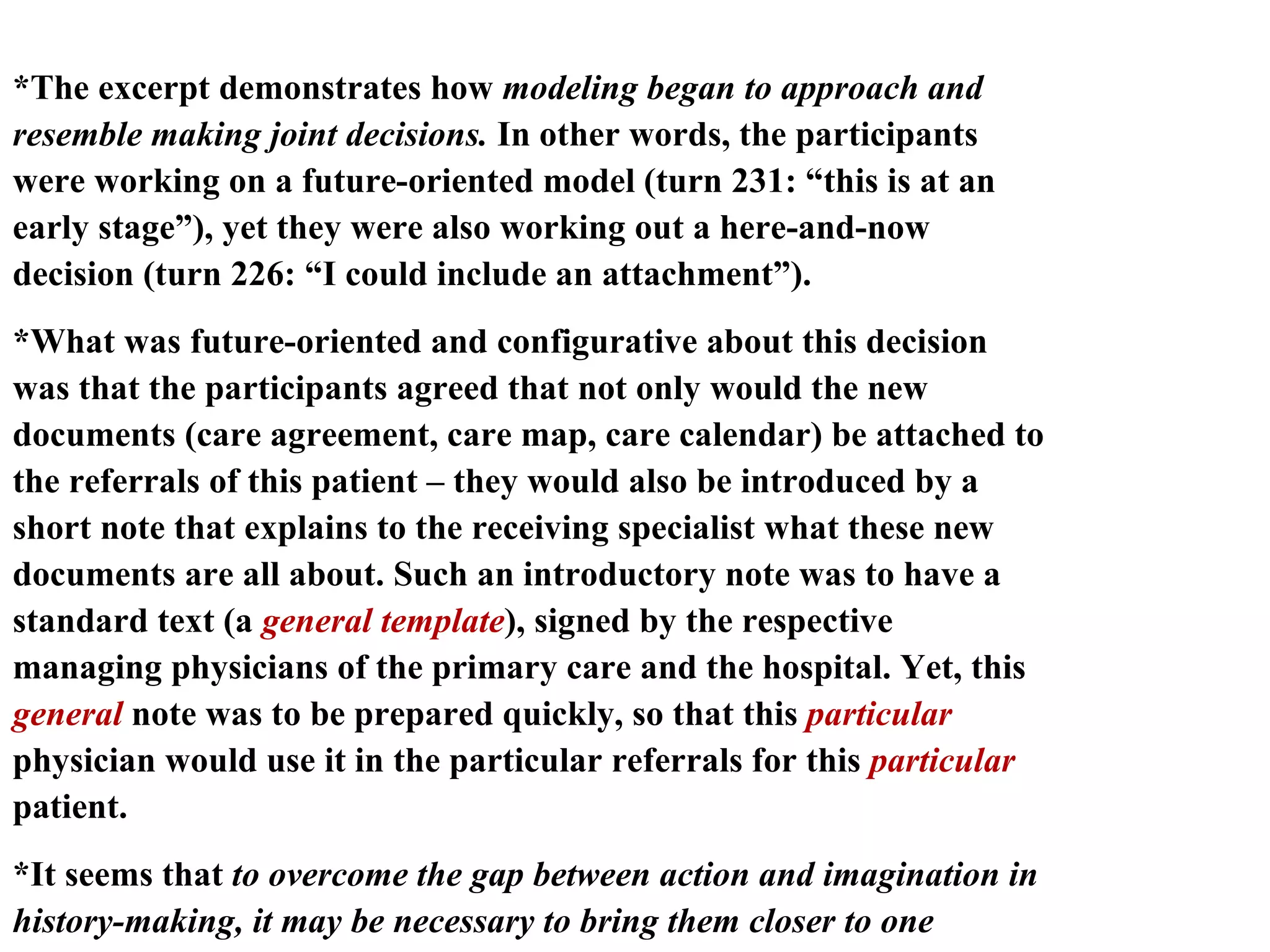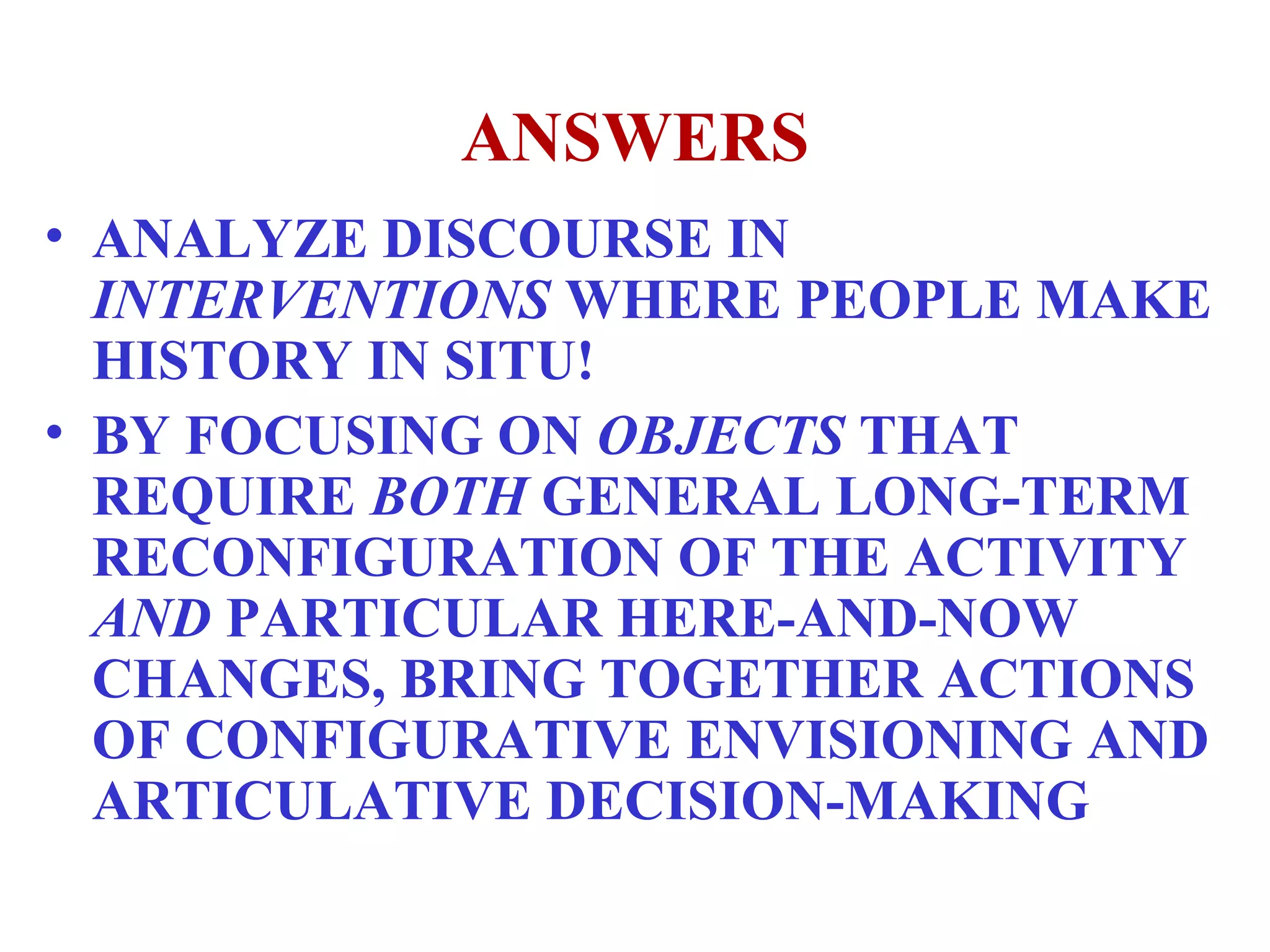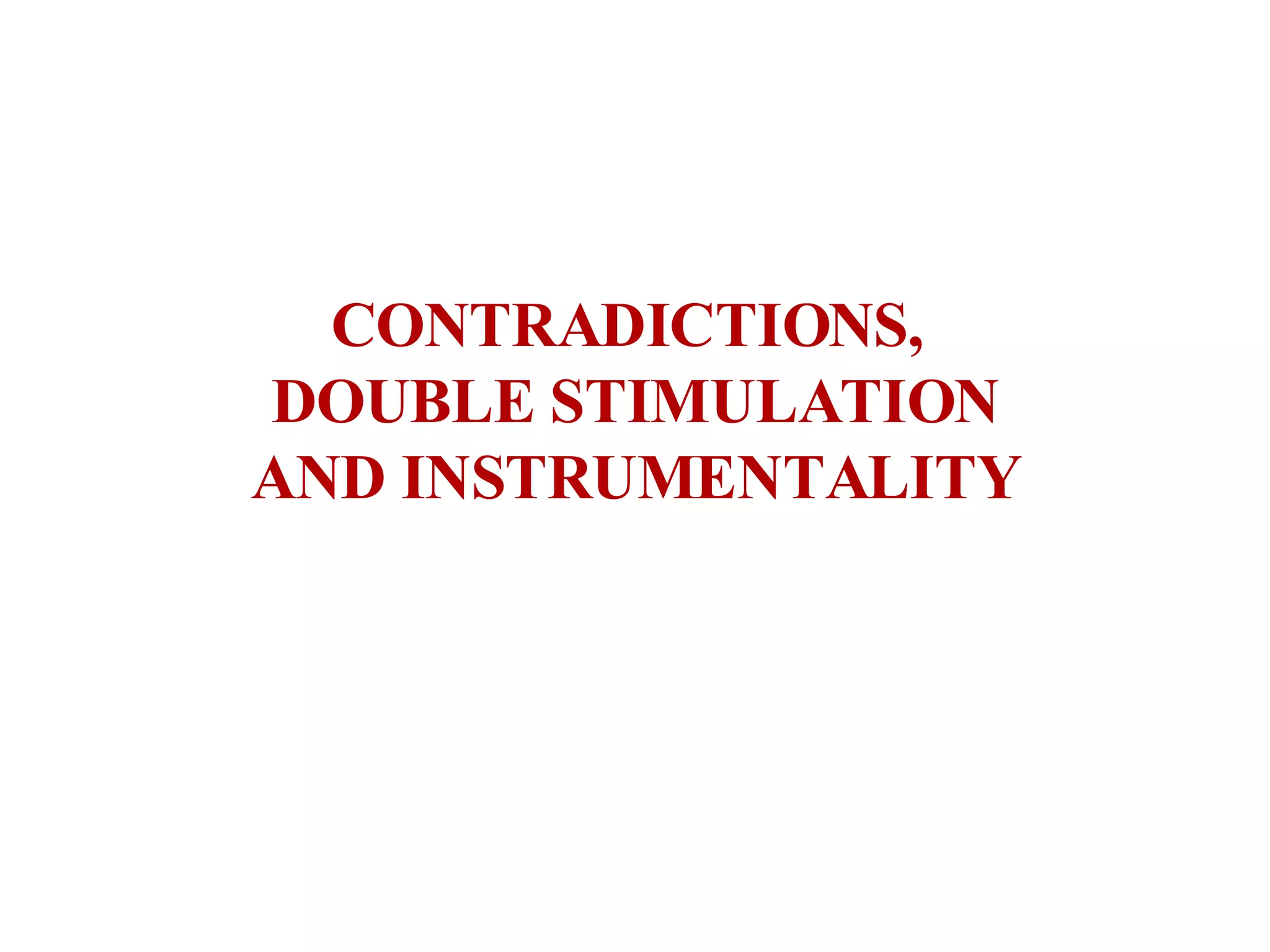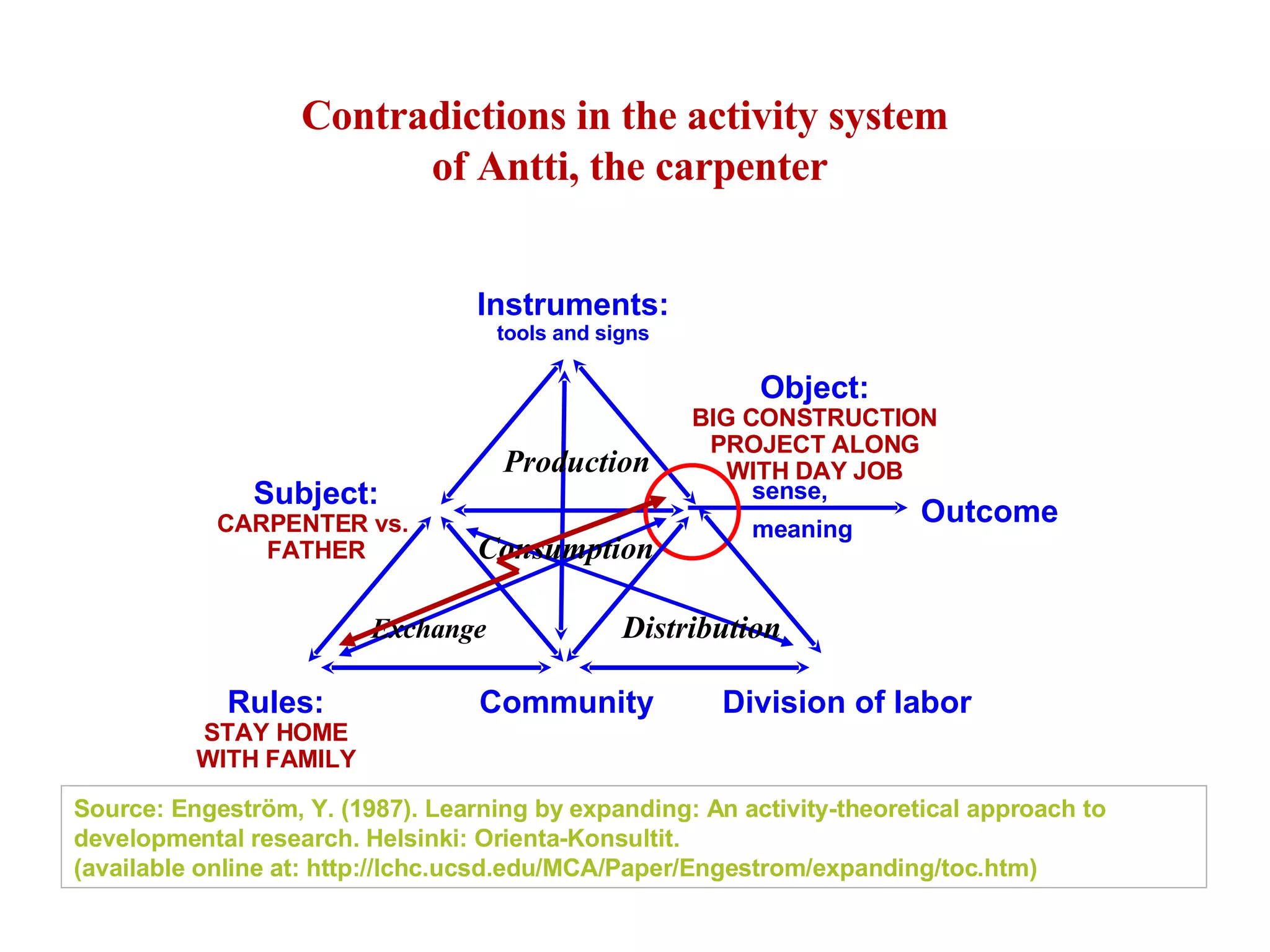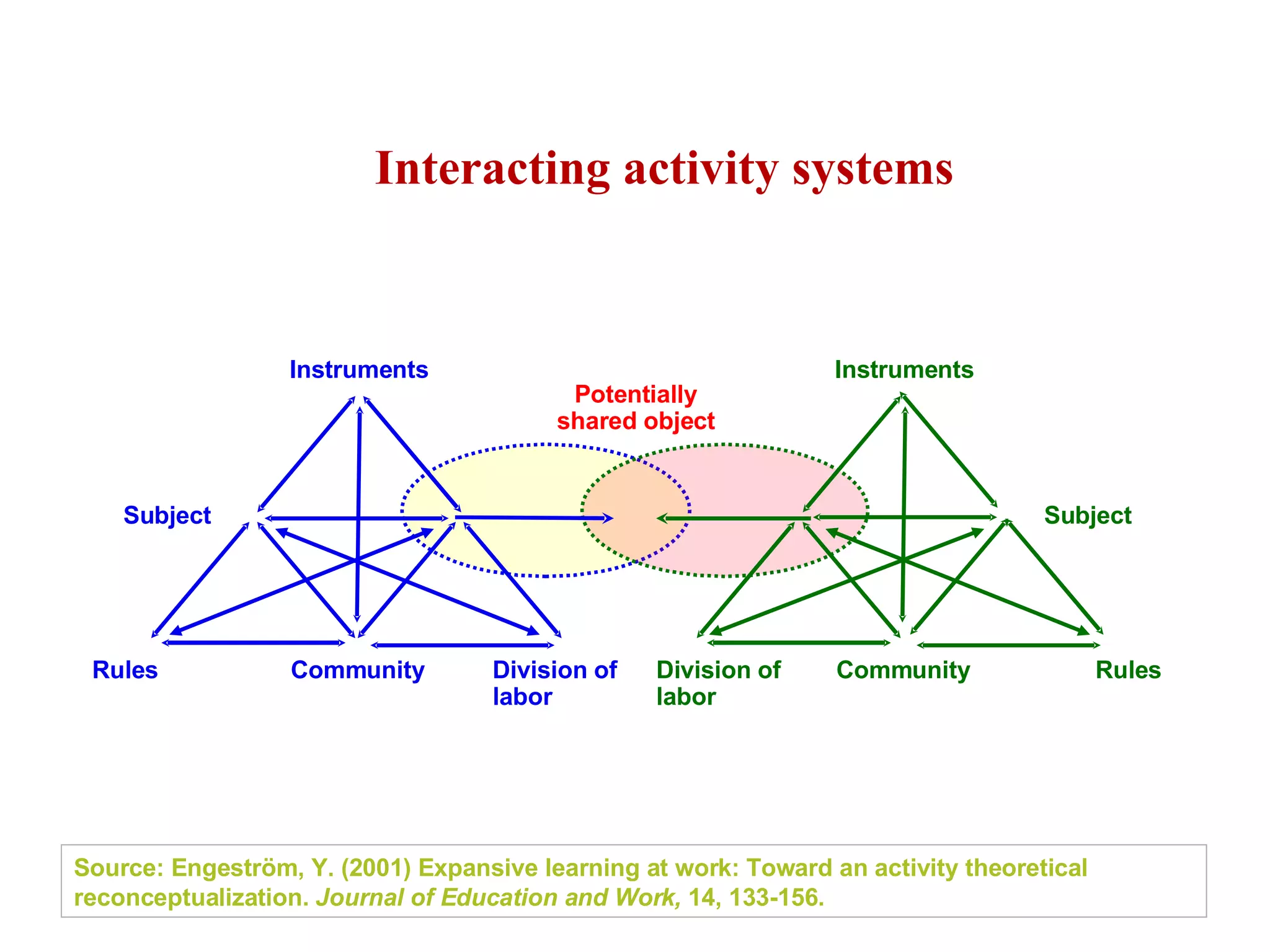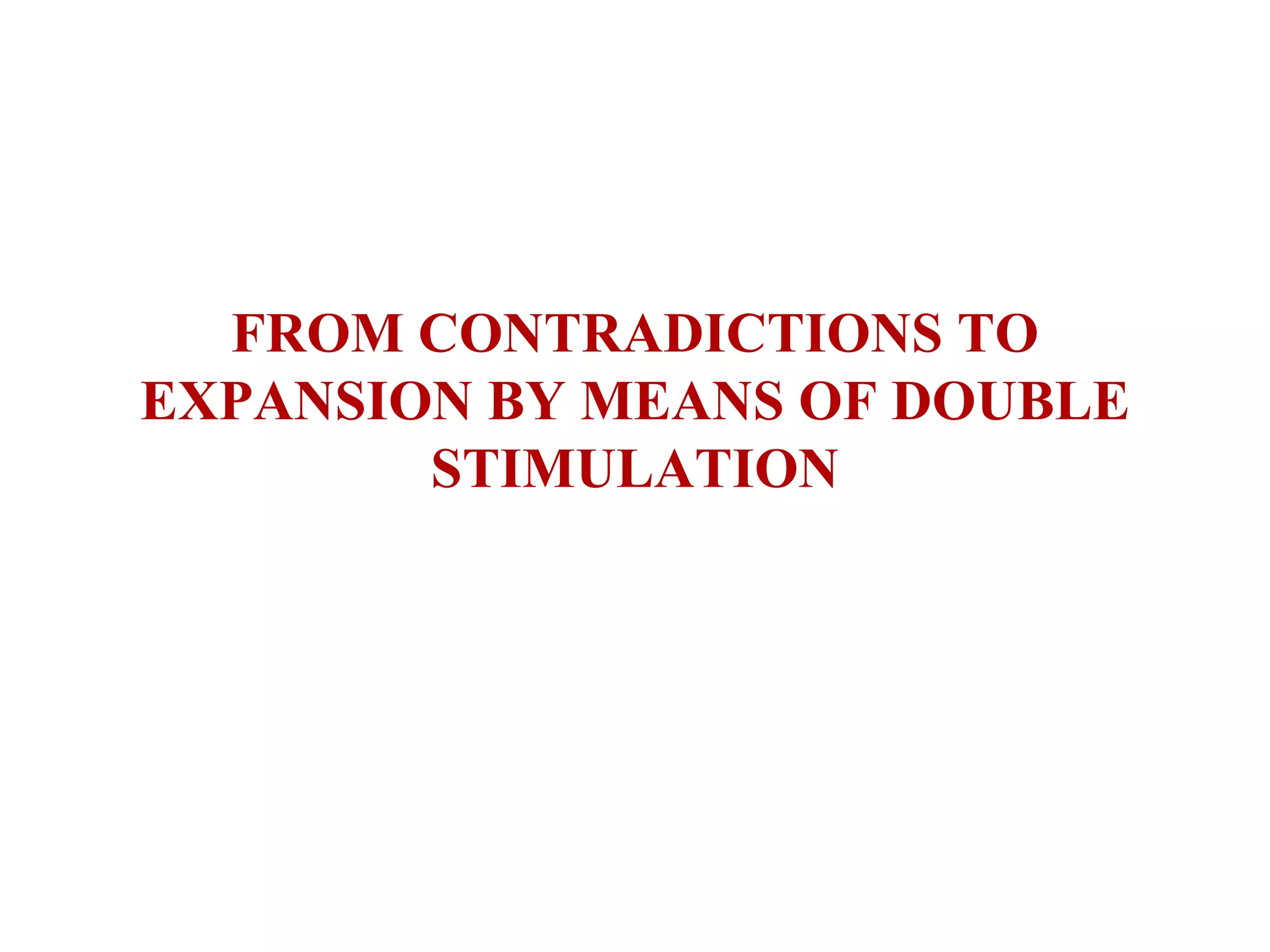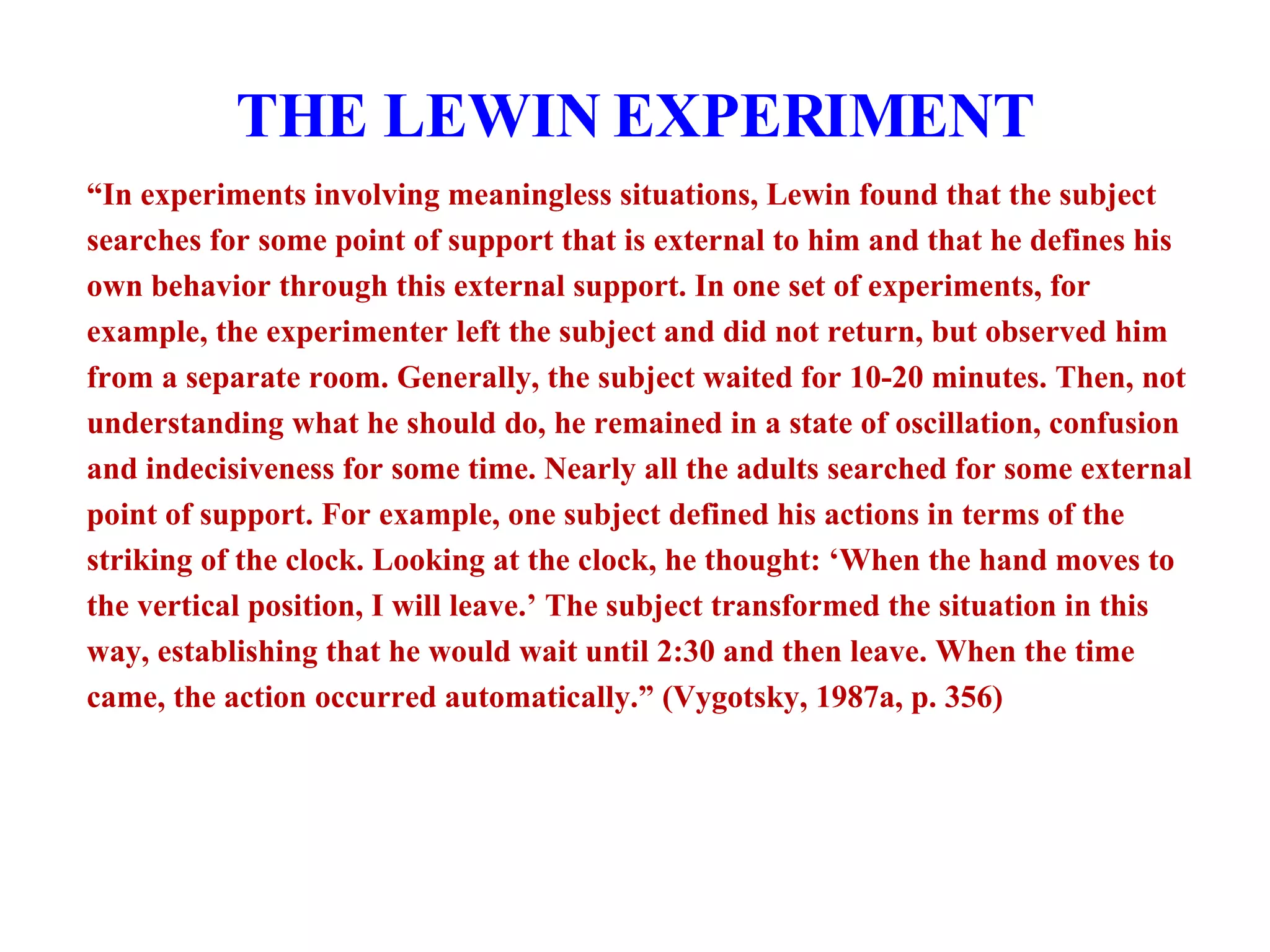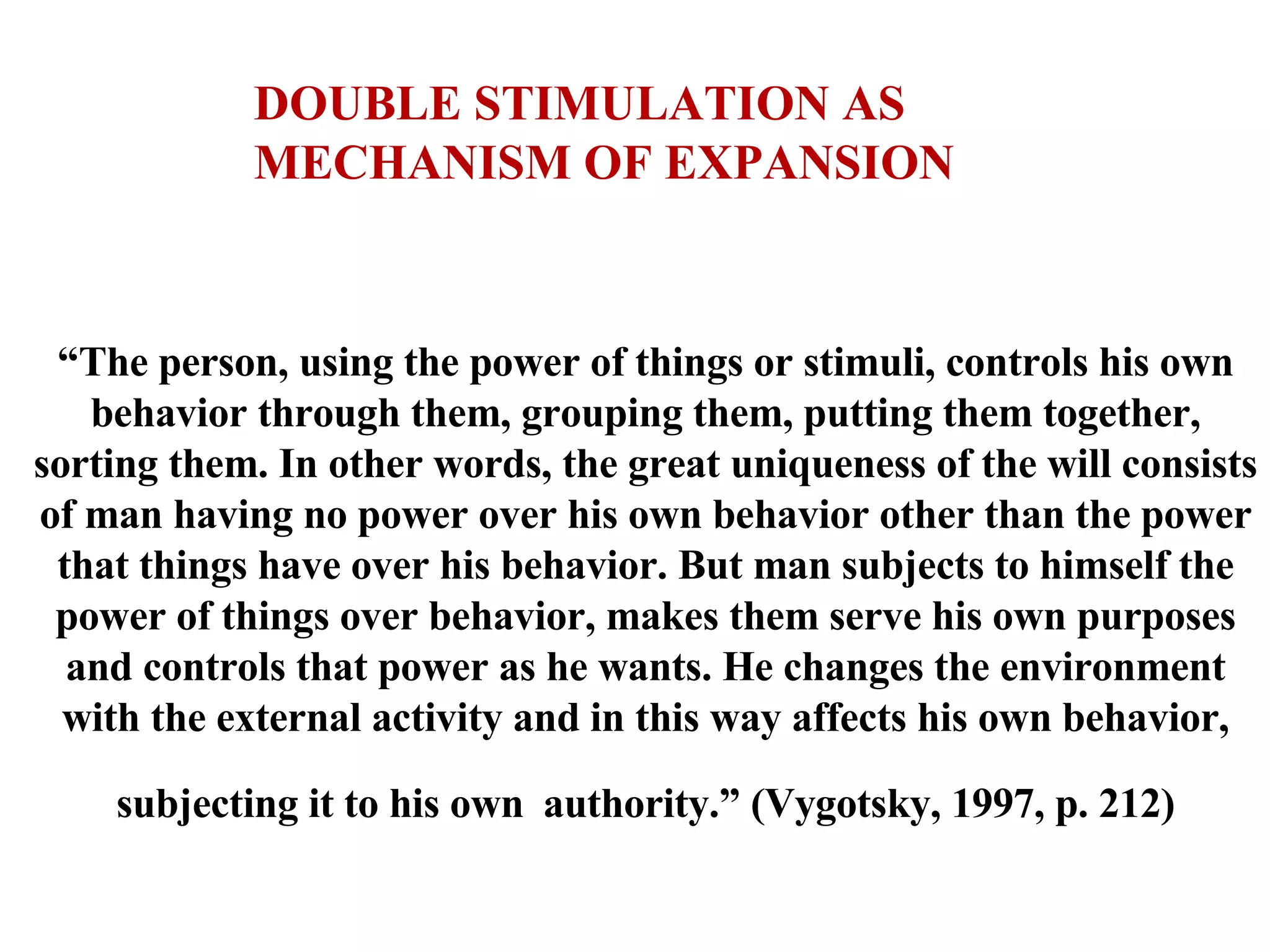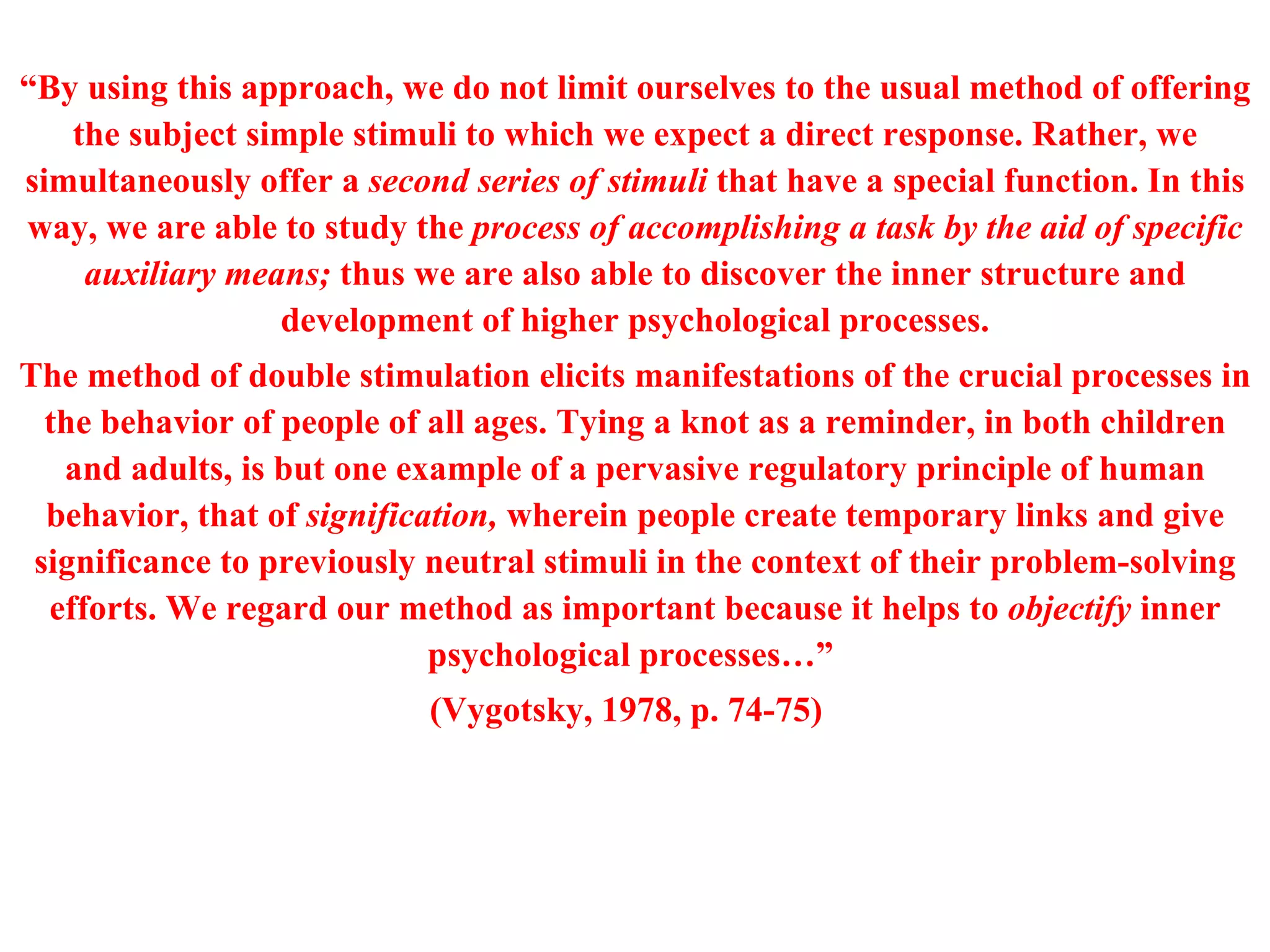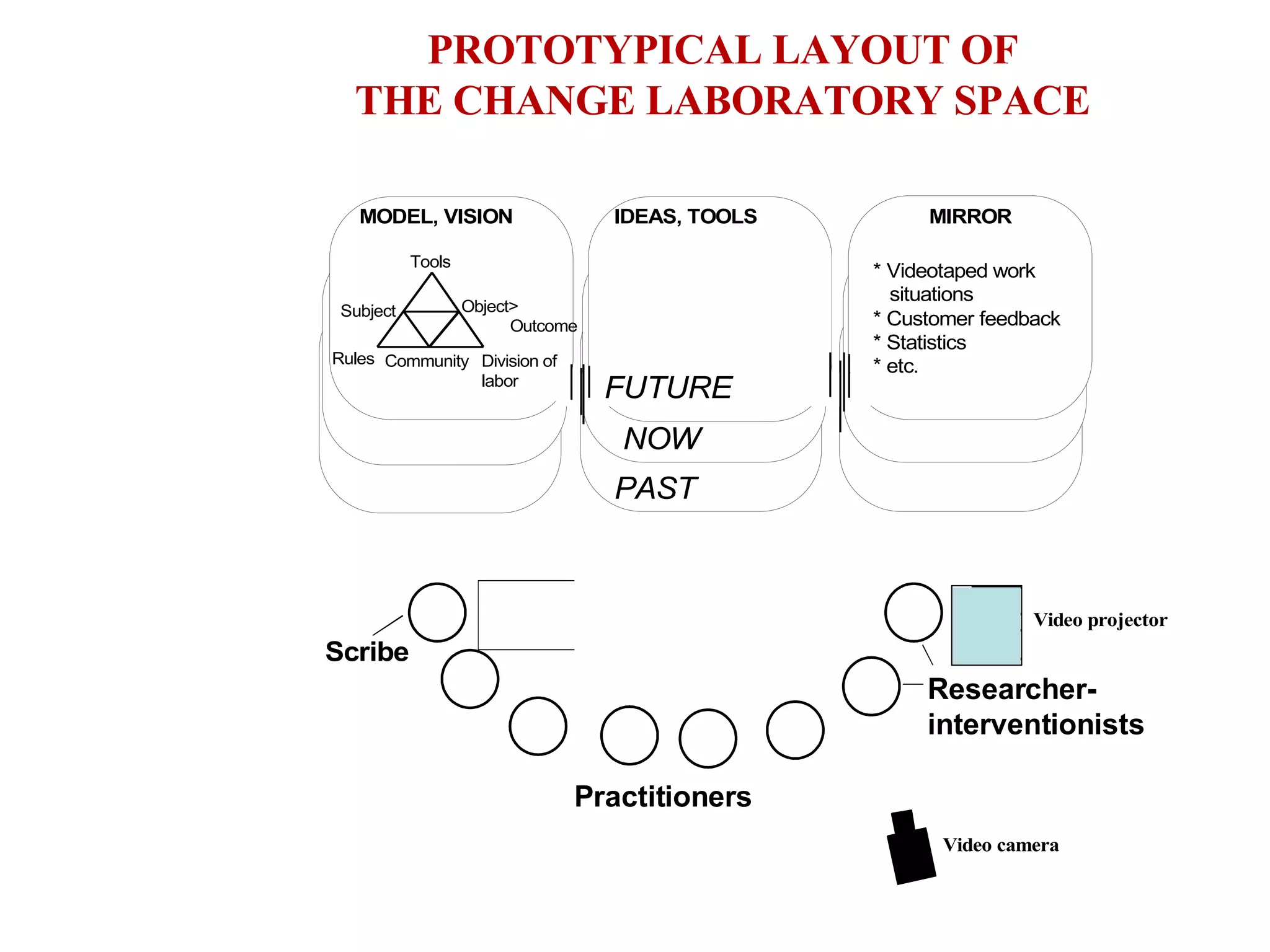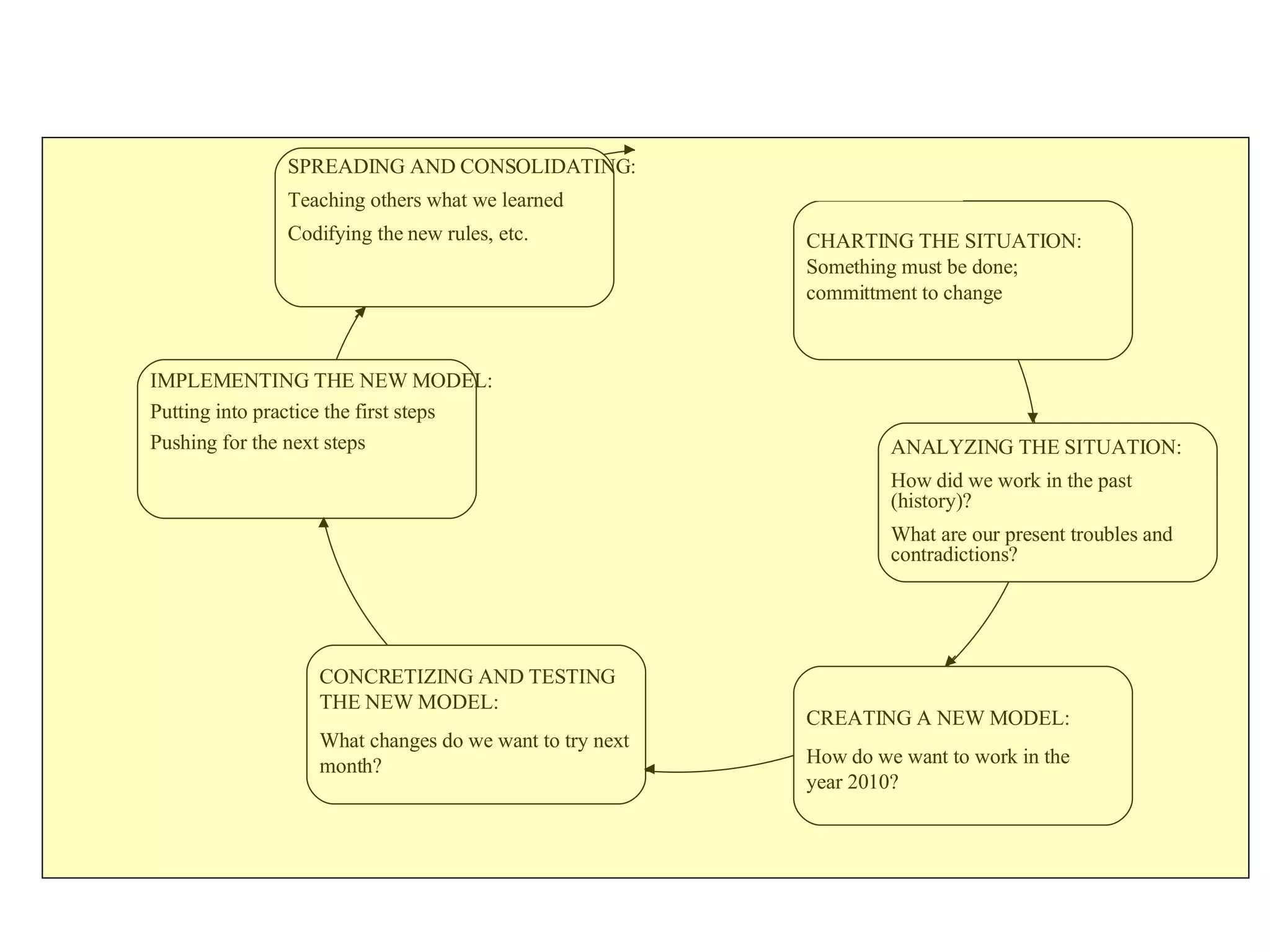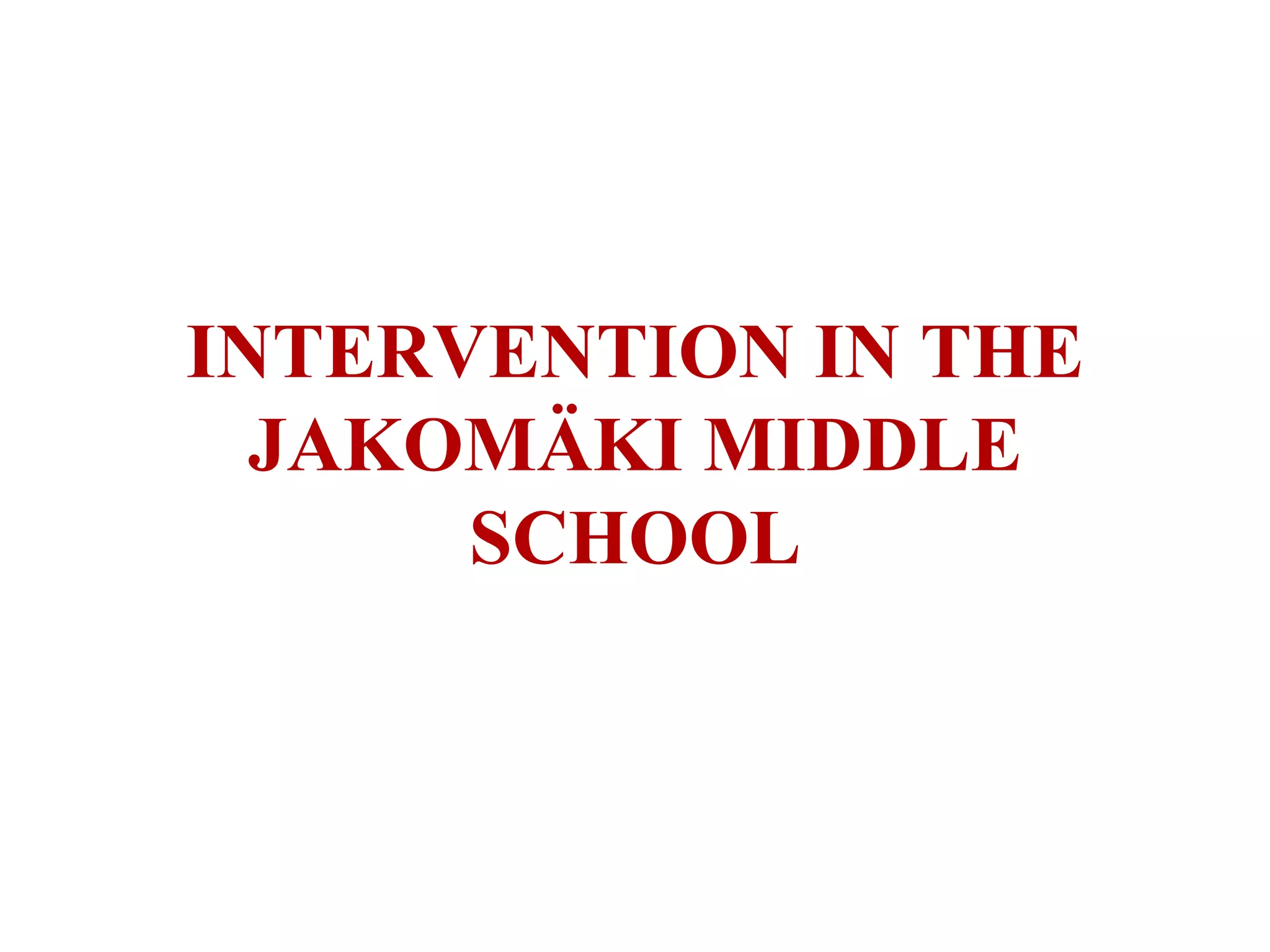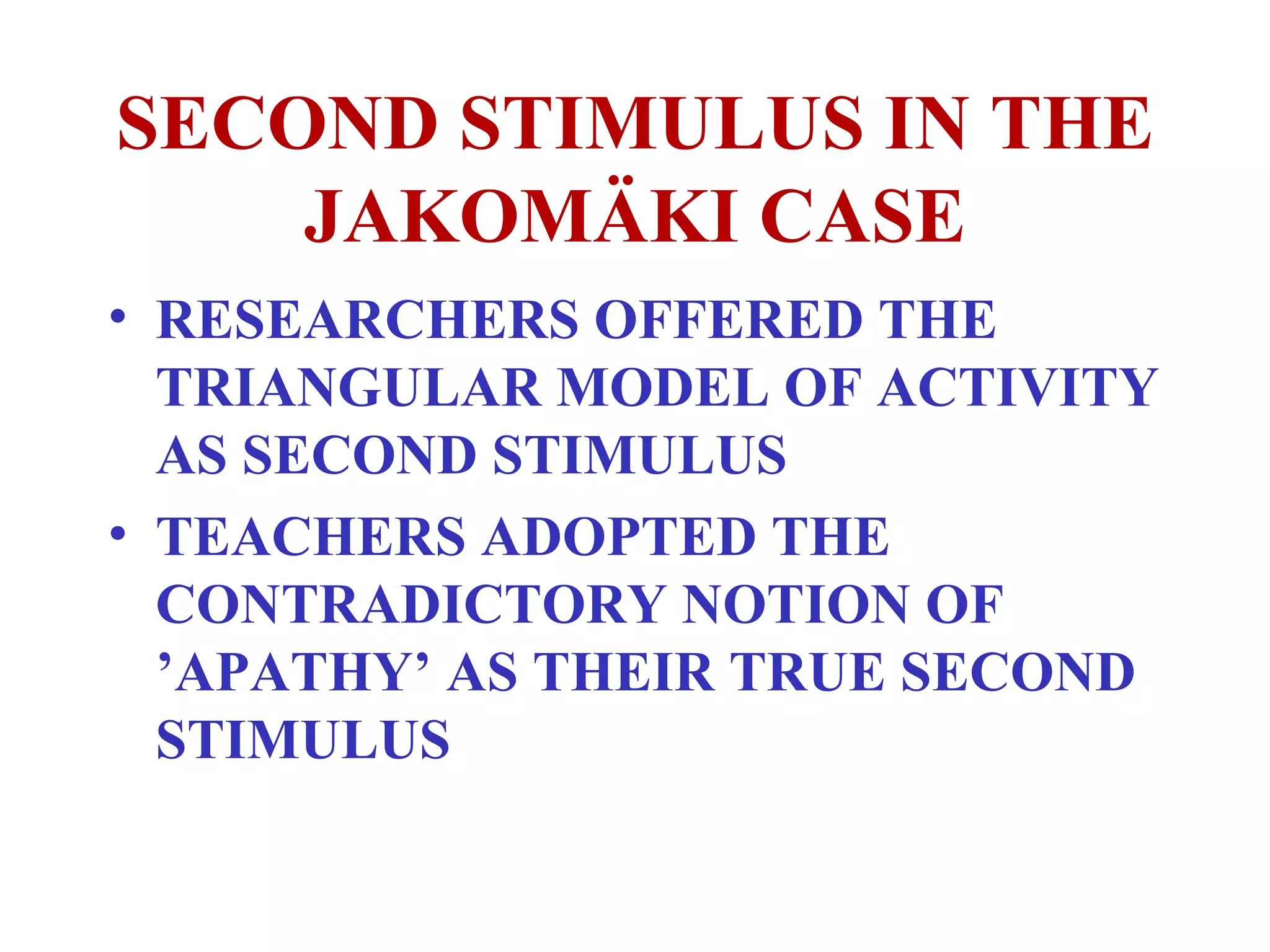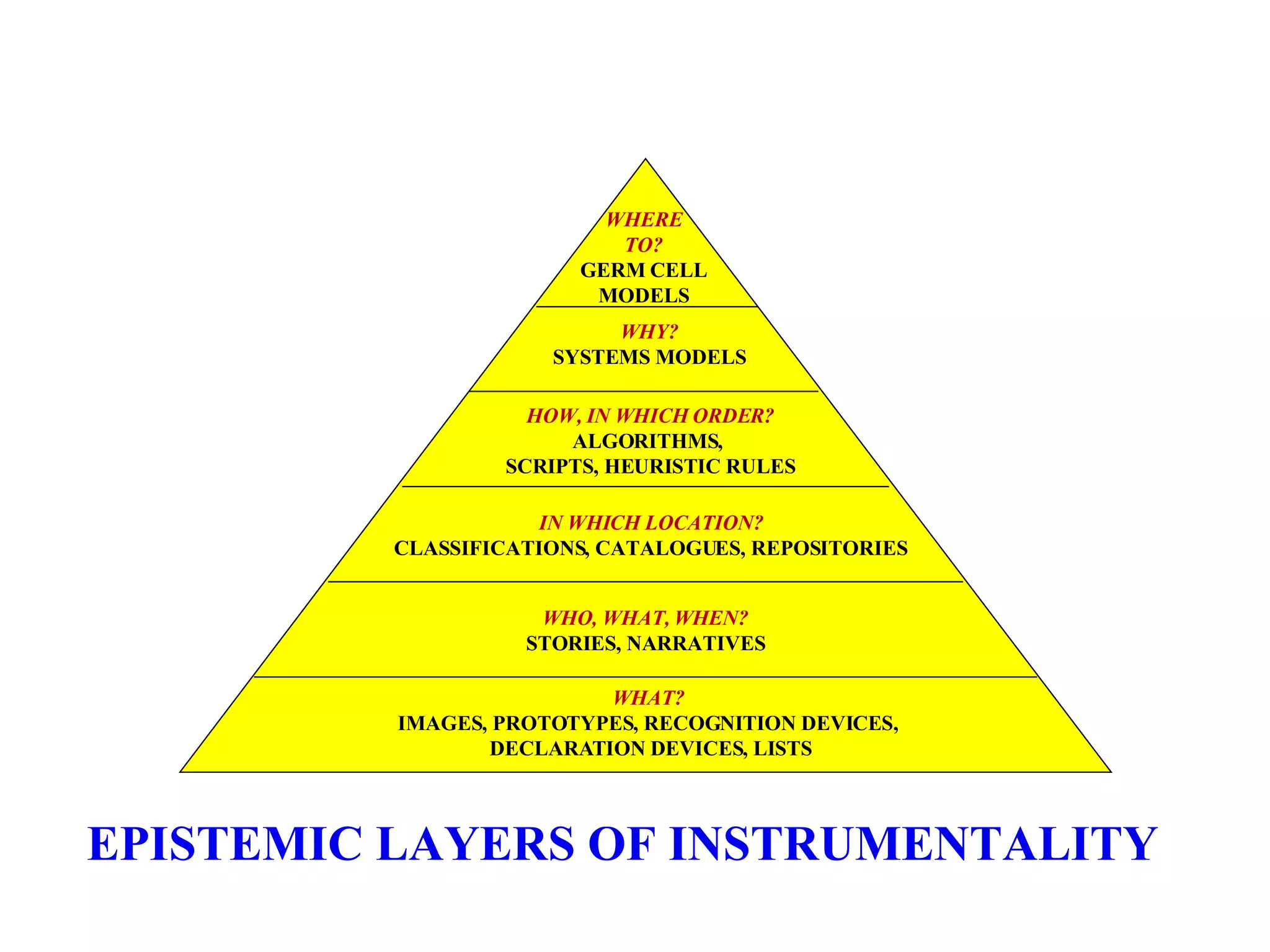The document discusses four key themes of activity theory:
1. Instrumental and semiotic layers of mediation in activity including talk, text, pictures, gestures, sounds, tools, and signs.
2. Contradictions and history making through re-mediation, double stimulation, and agency.
3. A transcript is provided as an example of instrumentalities in activity between two workers.
4. The harmonica model is referenced as representing the different layers of activity.

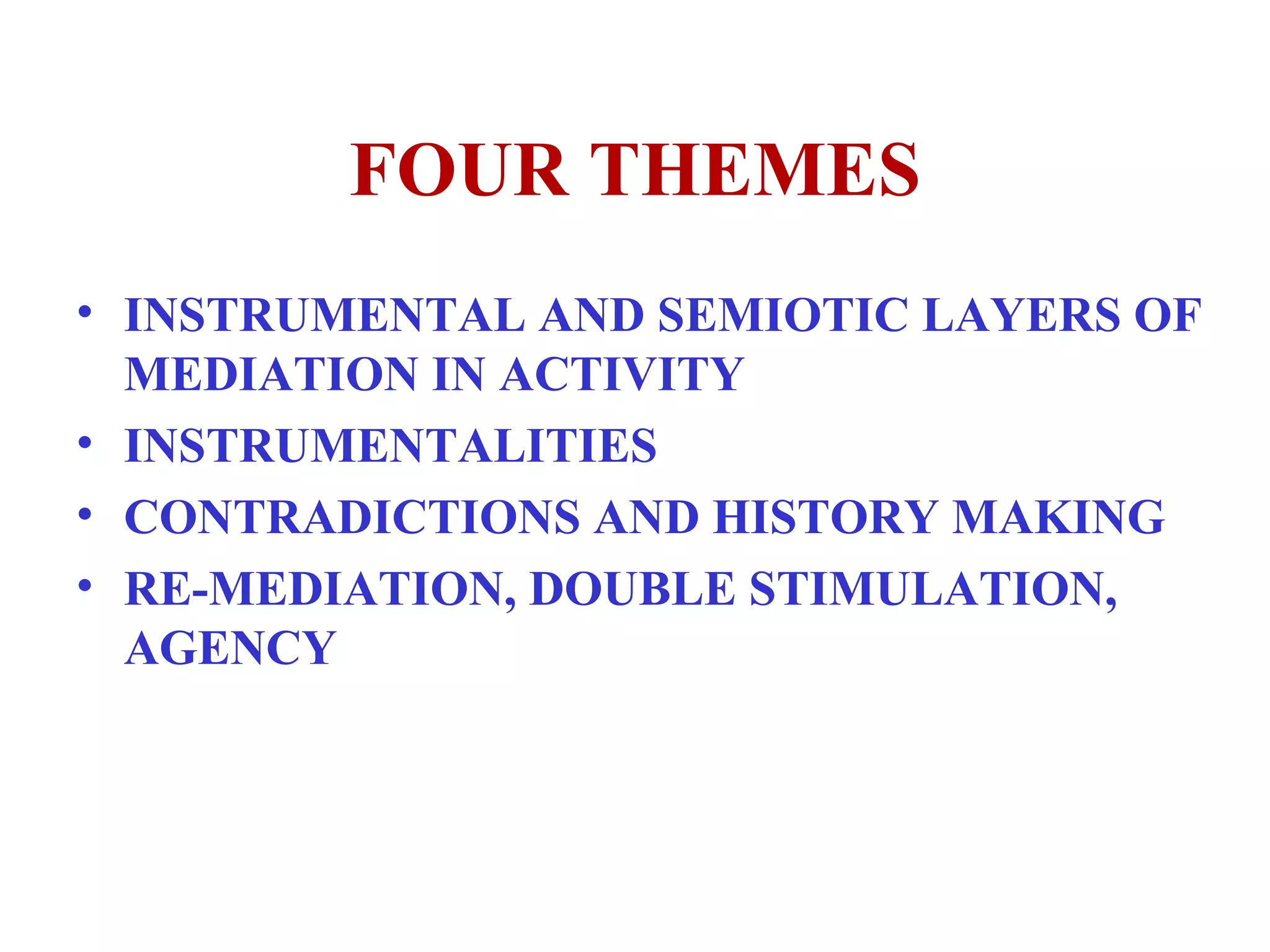
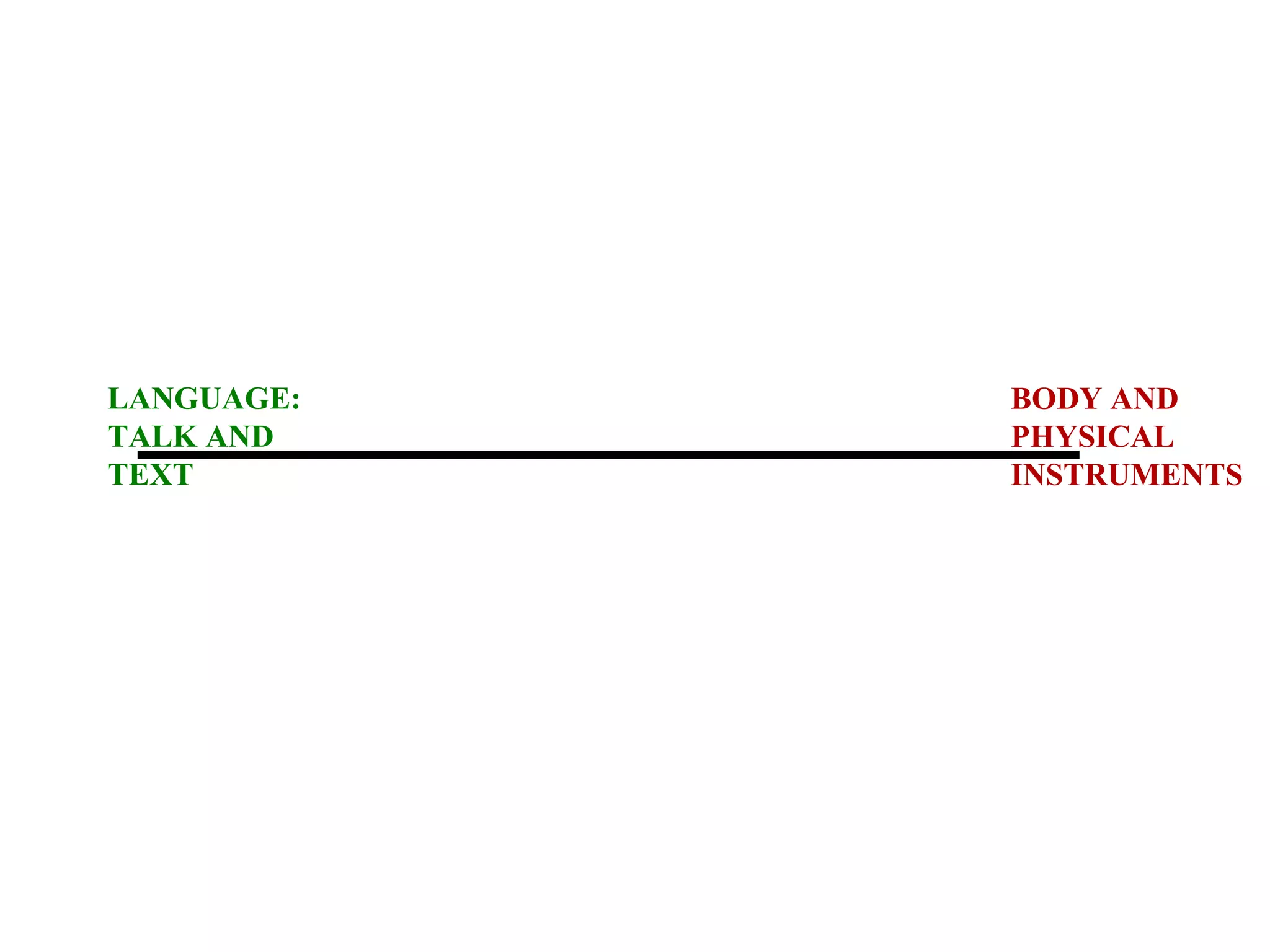
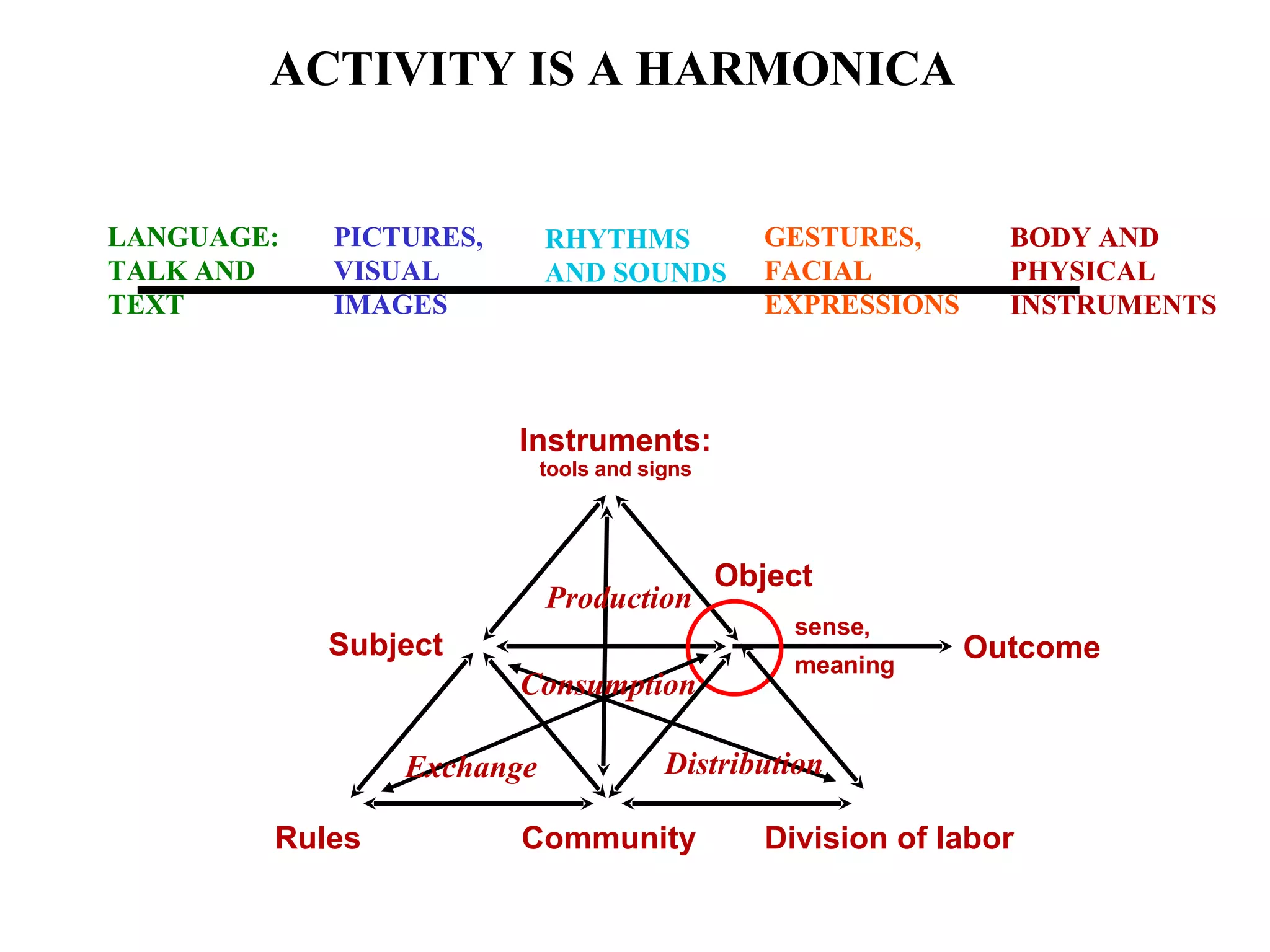
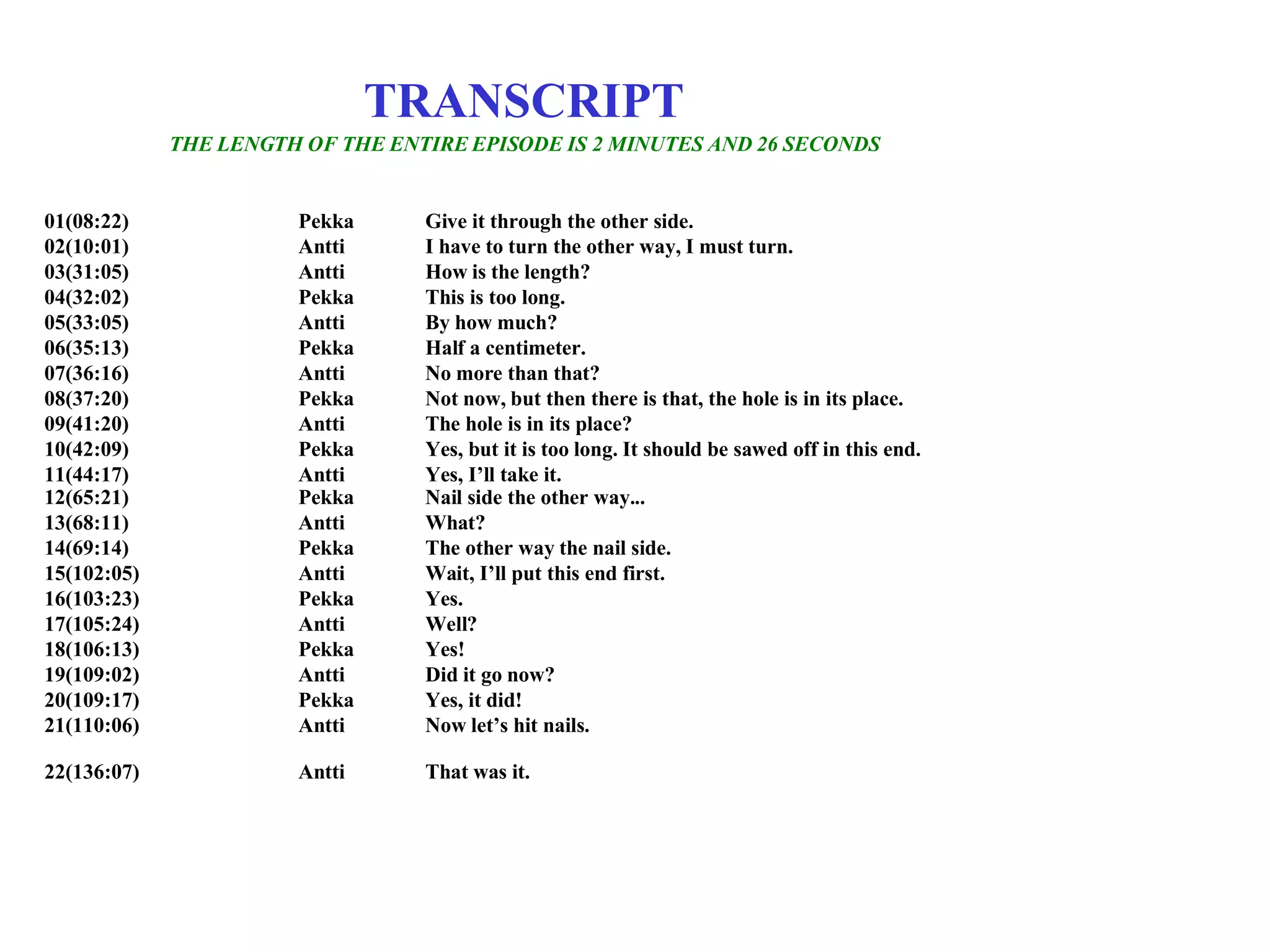
![[IN THE FOLLOWING, PEKKA ASKS ANTTI TO PUSH A PLANK UNDERNEATH THE HOUSE ON THE OTHER SIDE OF THE PILLAR BECAUSE IT IS ABOUT TO GO INTO THE WRONG SIDE. ANTTI STATES THAT HE MUST HIMSELF FIRST CHANGE THE SIDE IN ORDER TO BE ABLE TO PUSH THE PLANK INTO THE CORRECT SIDE. THIS IS THE DISTURBANCE no. 1.] 01(08:22) Pekka Give it through the other side. 02(10:01) Antti I have to turn the other way, I must turn. [IN THE FOLLOWING THE TRANSCRIPT EXPLAINS ITSELF. THIS IS THE DISTURBANCE no. 2.] 03(31:05) Antti How is the length? 04(32:02) Pekka This is too long. 05(33:05) Antti By how much? 06(35:13) Pekka Half a centimeter. 07(36:16) Antti No more than that? 08(37:20) Pekka Not now, but then there is that, the hole is in its place. 09(41:20) Antti The hole is in its place? 10(42:09) Pekka Yes, but it is too long. It should be sawed off in this end. 11(44:17) Antti Yes, I’ll take it. [IN THE FOLLOWING, PEKKA INDICATES THAT WHEN A PLANK IS PUSHED INTO ITS PLACE UNDERNEATH THE HOUSE WITH THE NAILS STICKING OUT ON THE DOWNSIDE, THE LONG NAILS SCRAPE THE DIRT AND MAY GET STUCK IN THE DIRT – THAT’S WHY THE PLANK SHOULD BE PUSHED INTO ITS PLACE THE NAILS STICKING OUT ON THE UPSIDE, AND BE TURNED AROUND FOR HAMMERING ONLY WHEN IT IS IN ITS PLACE. ANTTI ACTS ACCORDINGLY AND PUSHES THE PLANK INTO ITS PLACE TURNED UPSIDE DOWN COMPARED TO THE FIRST ATTEMPT. ANTTI’S ACTION IS THE ONLY - BUT SUFFICIENT – CONFIRMATION FOR PEKKA THAT ANTTI HAS INDEED HEARD AND UNDERSTOOD PEKKA’S UTTERANCE. THIS IS THE DISTURBANCE no. 3.] 12(65:21) Pekka Nail side the other way... 13(68:11) Antti What? 14(69:14) Pekka The other way the nail side. CONSTRUCTION ACTIONS TRANSCRIPT THE LENGTH OF THE ENTIRE EPISODE IS 2 MINUTES AND 26 SECONDS](https://image.slidesharecdn.com/language-and-activity2755/75/Language-And-Activity-6-2048.jpg)
![[IN THE FOLLOWING ANTTI NOTICES THAT PEKKA HAS PUT HIS END OF THE PLANK UP, CONNECTED TO THE END OF ANOTHER PLANK WHICH IS ALREADY IN ITS PLACE. BUT ANTTI CANNOT RAISE UP HIS END OF THE PLANK BECAUSE IN THE PILLAR TO WHICH THE PLANK MUST BE ATTACHED THERE IS A PROTRUSION WHICH PREVENTS THE RAISING OF THE PLANK (see the figure below). THEREFORE ANTTI ASKS PEKKA TO LET HIM RAISE FIRST HIS END OF THE PLANK. PEKKA DOES NOT IMMEDIATELY REALIZE THAT THIS MEANS THAT HE MUST LOWER HIS END OF THE PLANK (thus the two-second pause between turns 16 and 17). ANTTI’S TURN ‘Well?’ (turn 17) ALERTS PEKKA TO REALIZE THE SITUATION AND HE LOWERS HIS END OF THE PLANK IN A WAY THAT MAKES IT POSSIBLE FOR ANTTI TO RAISE HIS END OF THE PLANK – AND THUS ALSO THE WHOLE PLANK - INTO ITS PLACE. THIS IS DISTURBANCE no. 4.] 15(102:05) Antti Wait, I’ll put this end first. 16(103:23) Pekka Yes. 17(105:24) Antti Well? 18(106:13) Pekka Yes! 19(109:02) Antti Did it go now? 20(109:17) Pekka Yes, it did! 21(110:06) Antti Now let’s hit nails. 22(136:07) Antti That was it.](https://image.slidesharecdn.com/language-and-activity2755/75/Language-And-Activity-7-2048.jpg)
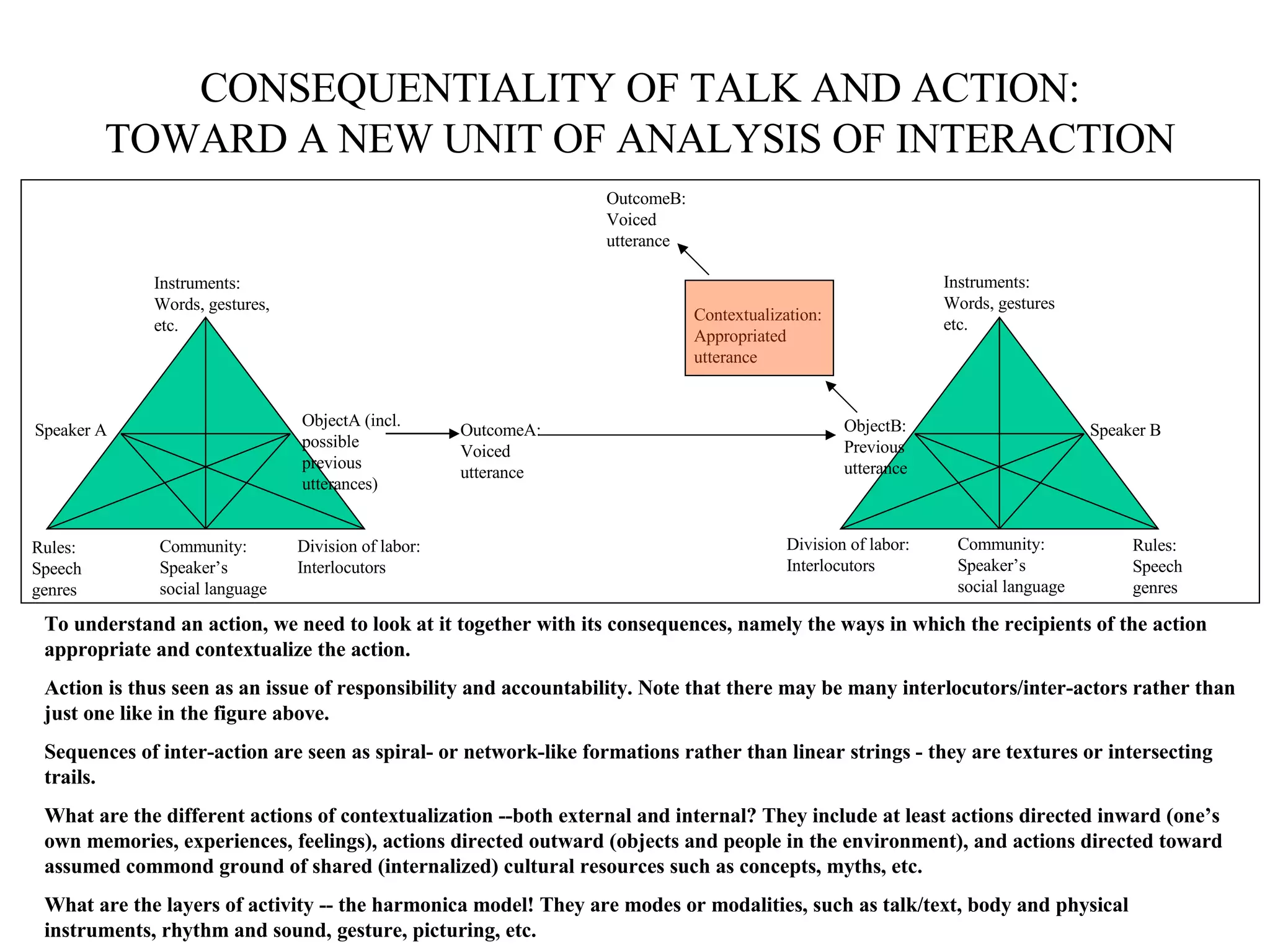
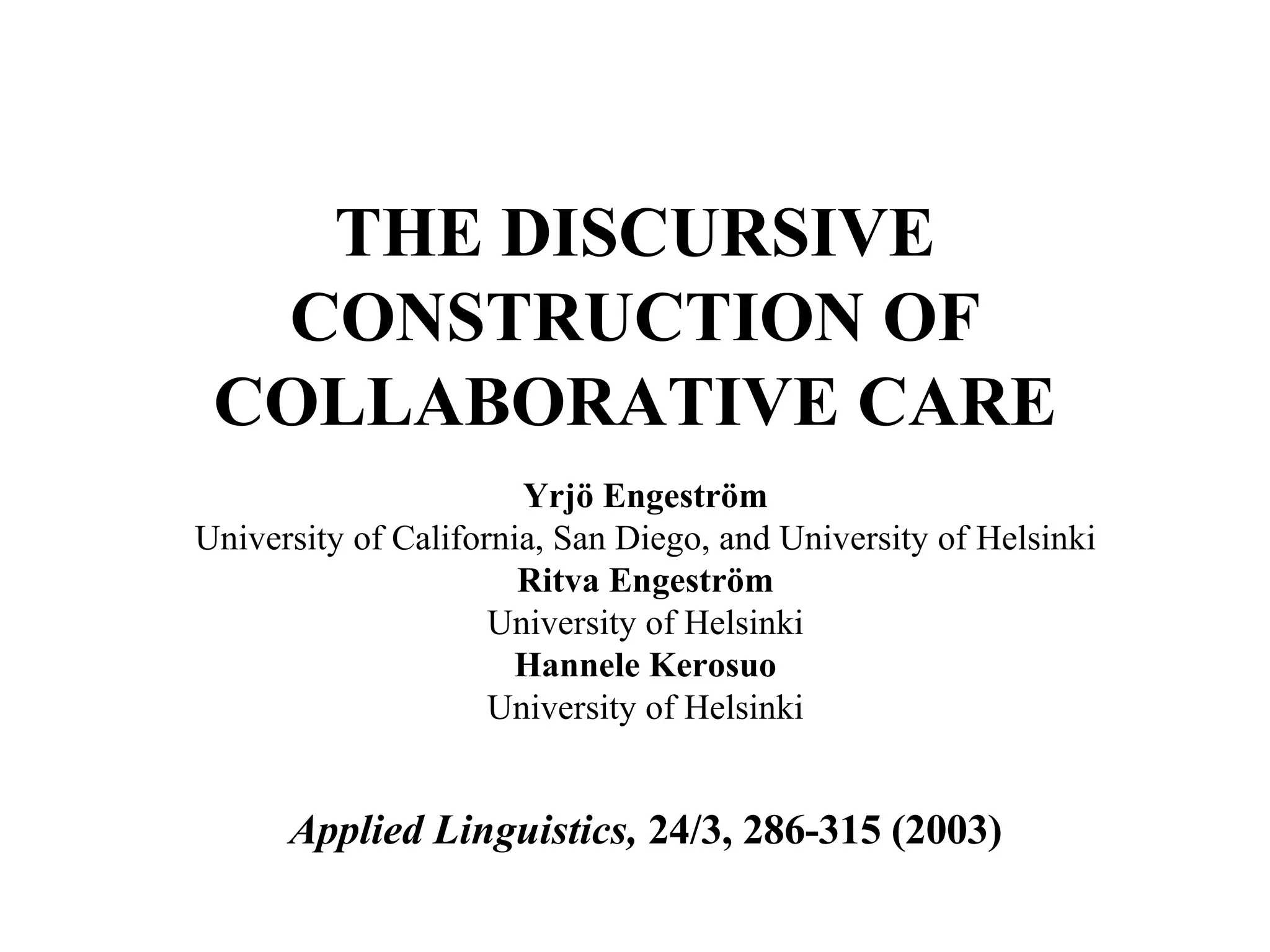
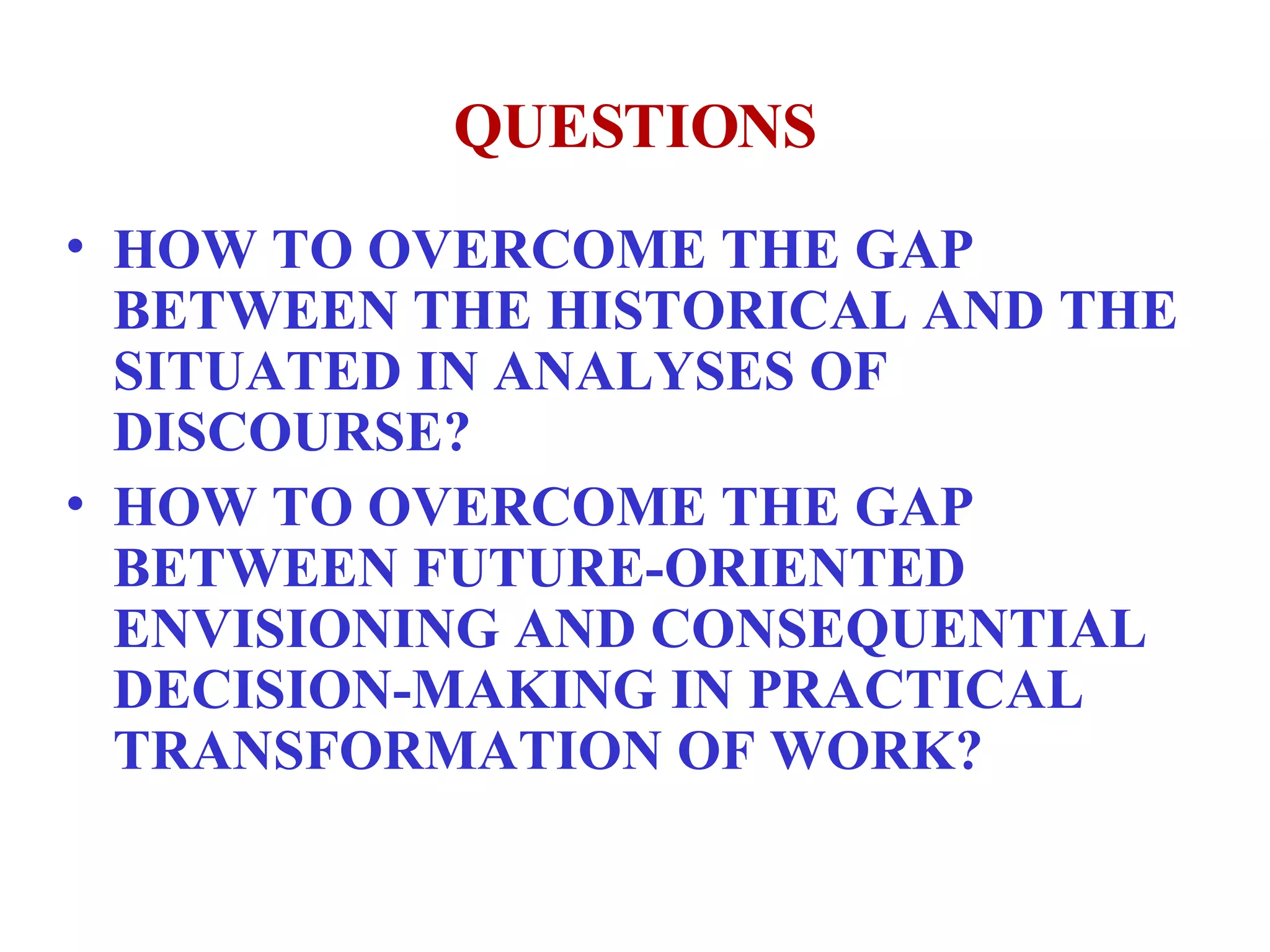
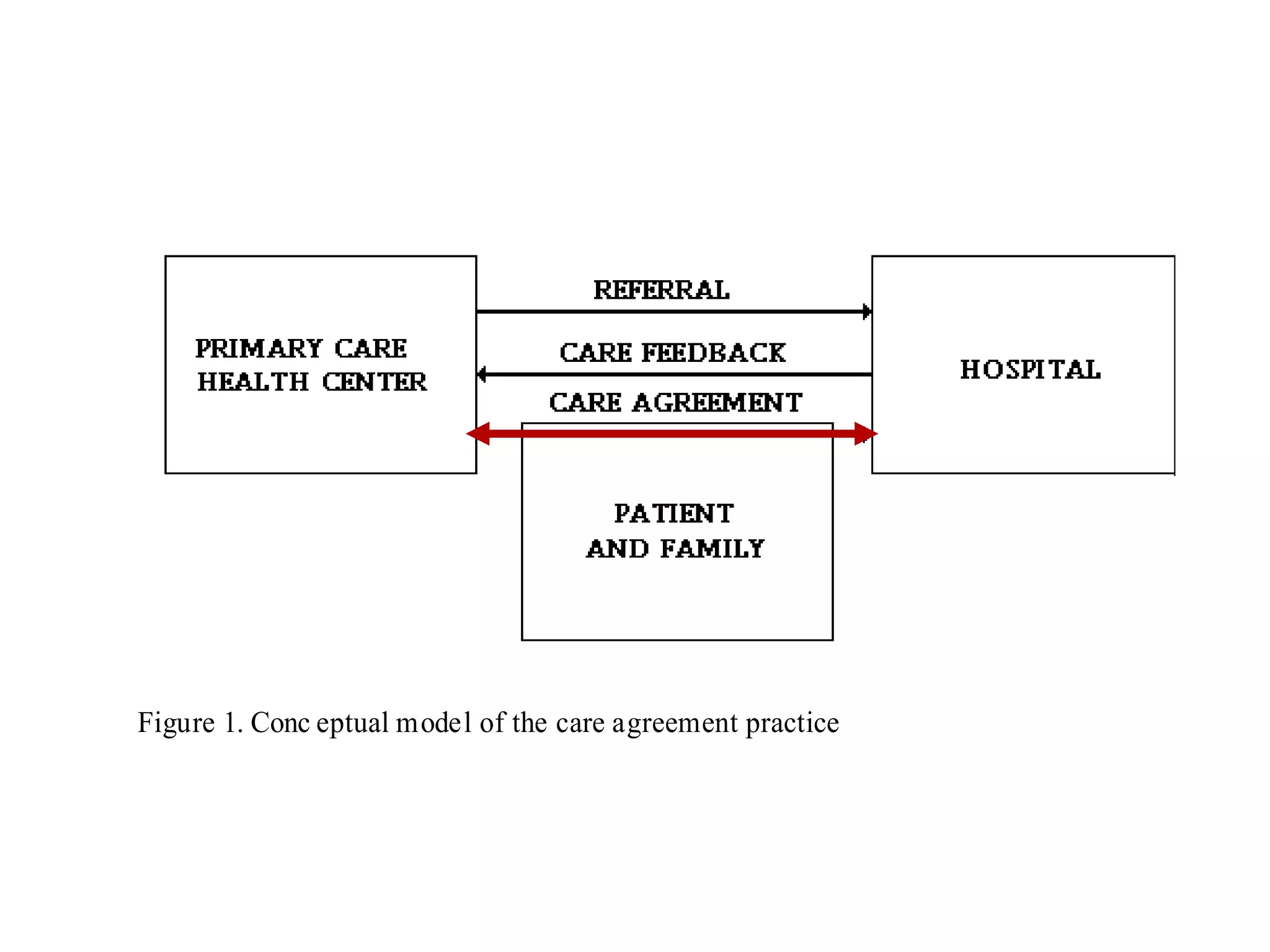

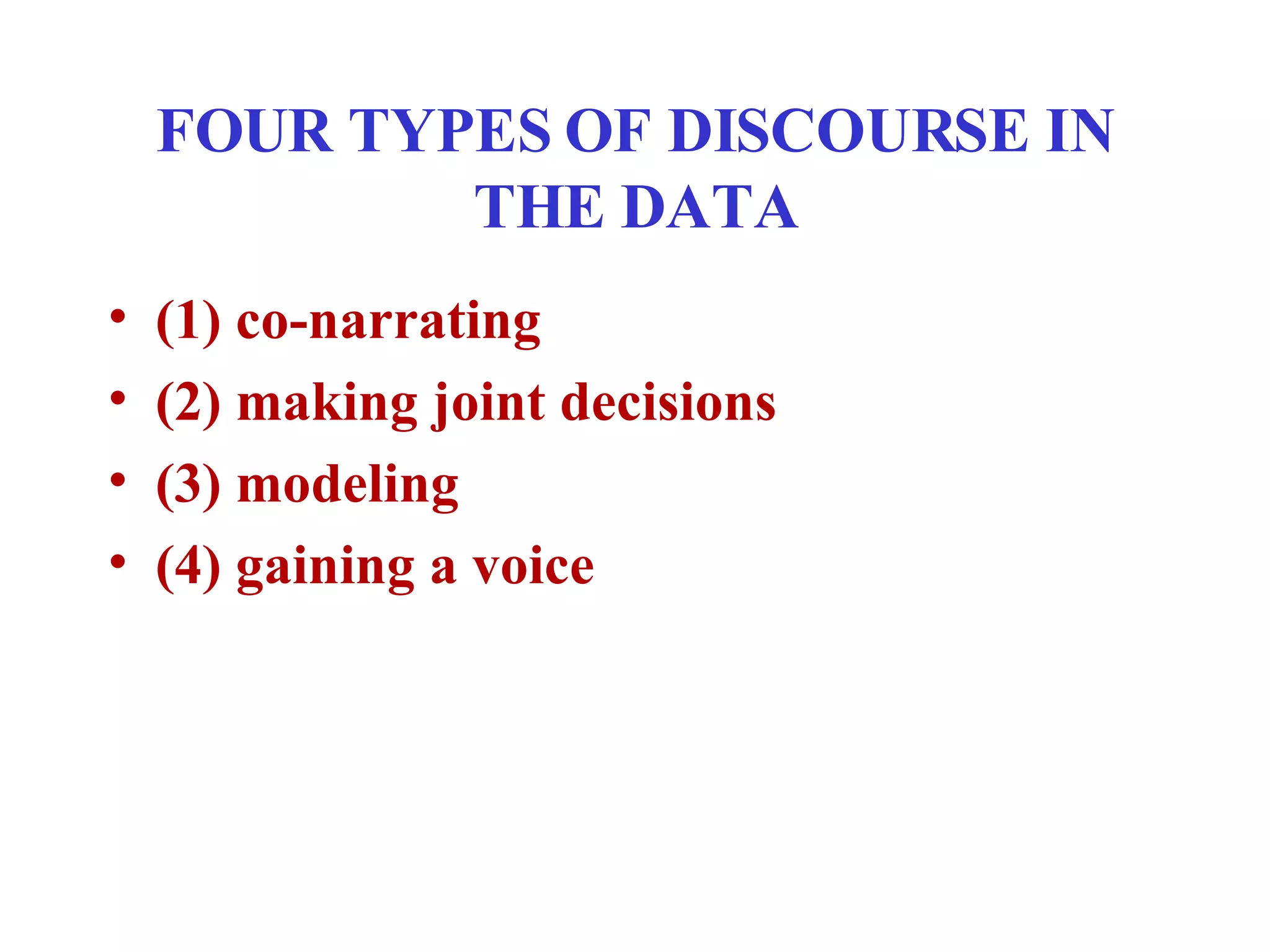
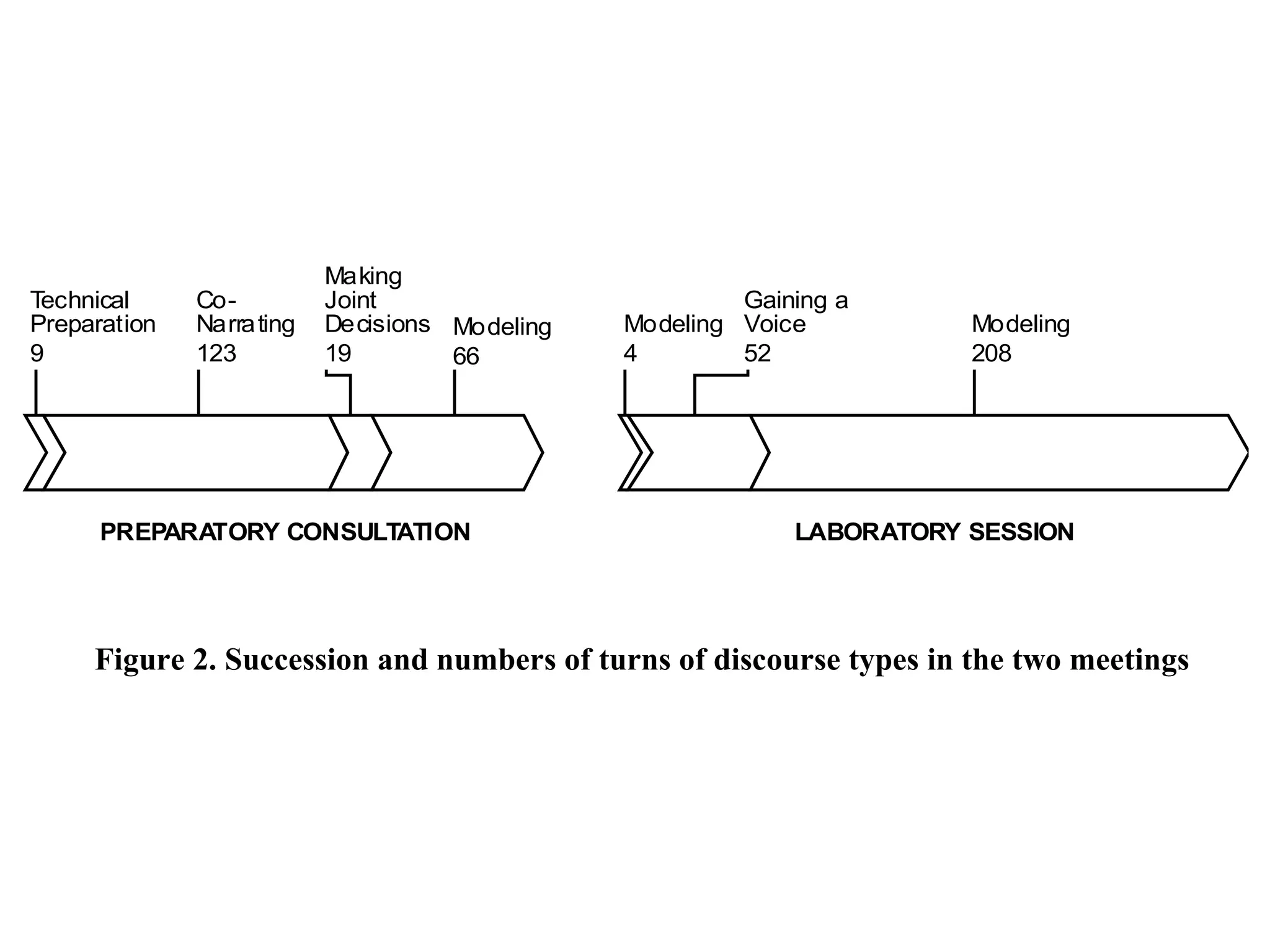
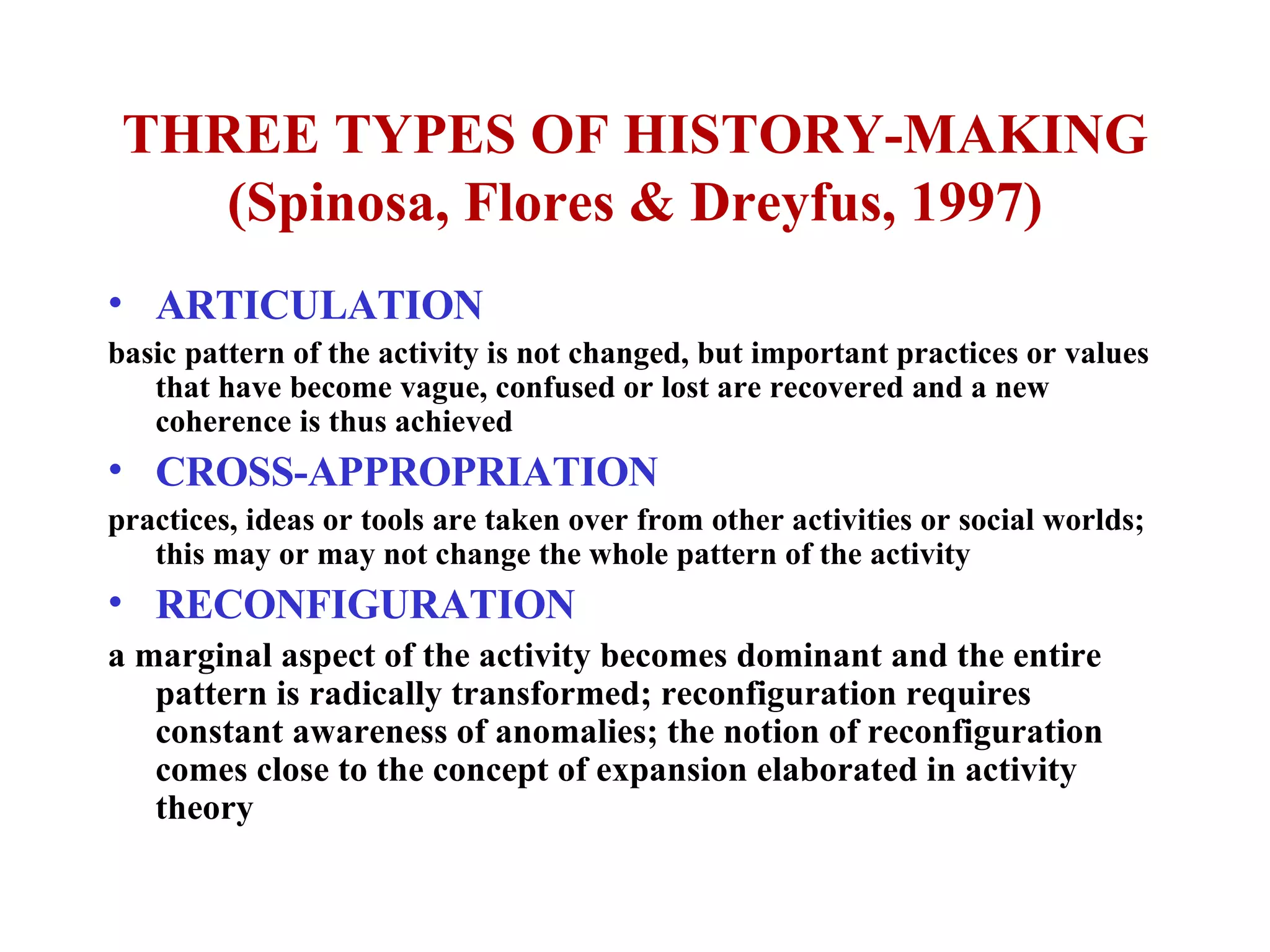

![199 Researcher 2: What are we going to do with this agreement, what will be done with it now? 200 Researcher 1: Isn’t it so that O [the GP] will follow the situation at this point… 201 Researcher 2: …Yes but this… 202 Researcher 1: …because there aren’t clearly identified partners yet, before these are cleared up, these ongoing examinations and tests and their results. 203 GP: Yes, we still miss the signatures, so… 204 Researcher 2: Well. 205 Researcher 1: Or what do you have in mind? 206 Researcher 2: Well, I just asked, what do you think, now that such a document has been prepared, so… 207 Researcher 1: Or all this groundwork, yes. 208 Researcher 2: Groundwork, what will be done with it. And now that O [the GP] refers R [the patient] to different places, would it be good if those different places to which she sends her for a specific problem, if they got to know about this whole picture in which this specific is…? 209 GP: Well, do I understand correctly, that I’d attach to it [the referral] this whole bundle, if someone there wants to quickly glance through it. How much would it then…? If I’m completely honest, having worked as a replacement for a specialist at one time, I sense that the less extra [paperwork] one got beyond one’s own specialty the happier most colleagues were. So what is the standpoint of the seniors here…? 210 Researcher 1: This is an interesting question when there is so much material coming from the personal physician.](https://image.slidesharecdn.com/language-and-activity2755/75/Language-And-Activity-17-2048.jpg)
![211 GP: Does it make a difference for how the process gets started in that end [in specialized hospital care]? Because if one learns this, […] so that one just learns to use this tool, then one just does it. Surely at some point this will be moved from paper-and-pencil over to the other type… 212 Researcher 1: …Soon, over to Pegasus… [computerized medical records system currently being implemented in the primary health care system of Helsinki] 213 GP: …yes, so surely it will be much easier in there …or somehow to pick it up from there. Or maybe some aid might do it there, or something like that… 214 Nephrologist: But in my opinion, when someone has done this work, this will be useful for all. 215 Researcher 1: There is no reason not to send it all with a small statement, telling that ‘here is background information which may be helpful, and I am ready to discuss if needed’, something like this. 216 Researcher 3: I think H [researcher 2] was thinking ‘why not attach this care agreement to the next referral’. 217 GP: Yes, but in my opinion it would also require these care calendars. 218 Researcher 3: Aha, those should be added to it, yes. 219 Researcher 1: Those calendars were clearly very important tools for you when you sorted through all of this. 220 GP: Yes, that’s how I started to make sense of the reality in which the lady had lived the years before returning to Finland and after it. 221 Researcher 1: Yes. 222 GP: It was not easy in the first consultation. I kind of thought when I was writing down those calendars that if I only had had this kind of a tool then. So that I would have been able to arrange these issues at once according to some jointly agreed-upon model. I experienced this as very good.](https://image.slidesharecdn.com/language-and-activity2755/75/Language-And-Activity-18-2048.jpg)
![223 Researcher 1: Right, yes. 224 GP: I mean, the first contact is heavy because there are so many things, and they have to be sorted, and that takes time. But it pays off in the longer run. 225 Researcher 1: Excellent, well, let’s quickly sum this up. Surely it is like you A [nefrologist] said, when such a work has been done, there is no sense in keeping it to one’s self. […] And it will be nice to hear what kind of feedback you’ll get on your referrals. […] 226 GP: I could include an attachment, or an attachment to a referral I already sent. 227 Nephrologist: May I say something? 228 Researcher 1: Yes. 229 Nephrologist: Now before this work is completed, it may be that somebody kind of, not gets aggravated but wonders, if these care agreements begin to come in, before this practice has been officially fixed and its implementation announced. 230 Researcher 1: Right, so in this case… 231 Nephrologist: …So this is at an early stage. So I think that if we now send it, surely the physician who receives the referral is glad to get as much information as possible. But it may require a small explanation. 232 Researcher 1: Just so. 233 GP: Yes.](https://image.slidesharecdn.com/language-and-activity2755/75/Language-And-Activity-19-2048.jpg)
